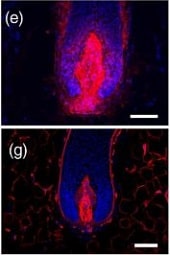A number of people asked me to write about microRNA (miRNA) and hair growth last year. The publication of four new miRNA and hair growth related studies in 2021 now makes it imperative to cover this subject.
MicroRNA and Hair Growth
- In July 2020 I briefly mentioned a new study from scientists at North Carolina State University pertaining to dermal exosomes and microRNA (miRNA).
Per the findings, microRNA shows promise for hair regrowth. In particular, the scientists also studied microRNAs (miRNAs) in dermal exosomes from both the 2D and 3D dermal papilla cells.
The research team identified a particular miRNA called miR-218-5p as a key promoter of hair growth. Per team lead Dr. Ke Cheng, cell therapy with 3D cells based on this work could be an effective treatment for baldness. However, you have to grow, expand, preserve and inject such cells into the balding areas.
“MiRNAs, on the other hand, can be utilized in small molecule-based drugs. So potentially you could create a cream or lotion that has a similar effect with many fewer problems.”
- In the latest January 2021 issue of Experimental and Molecular Pathology, a new study from China found yet another type of miRNA that impacts hair loss. In particular, the abnormal expression of miR-133b may inactivate the Wnt/β-catenin pathway. This ultimately impacts hair growth patterns. Moreover, the androgen dihydrotestosterone (DHT) can regulate miR-133b expression.
- Also see my post from 2015 in relation to microRNA-22 (miR-22) and hair loss. Update: November 2021 — A new study from China concluded that overexpression of miR-22 promotes apoptosis of dermal papilla cells.
- Update: June 2021 — A study from China found that conditional miR-24 ablation promotes hair regeneration.
- Update: August 2021 — A new study shows that increased microRNA-31 expression is associated with hair follicle aging.
- Update: June 2023 — MicroRNA-205 (miR-205) promotes hair regeneration by softening stiff hair follicle stem cells.
mRNA versus miRNA
Note that although closely related, messenger RNA (mRNA) is different from microRNA (miRNA). Messenger RNA is a single-stranded molecule of ribonucleic acid (RNA) that corresponds to the genetic sequence of a gene. MicroRNA is a small non-coding RNA molecule that functions in RNA silencing and post-transcriptional regulation of gene expression.
A company named Turn Biotechnologies is working on an mRNA based skin and hair regeneration treatment. Still in its early days. Update: January 2023 — They are covered at the bottom of this article.
Yet another early stage company named Omega Therapeutics is working on mRNA therapeutics to tackle alopecia. Make sure to read about the differences between RNA and DNA in case you do not know.
Faster mRNA based Hair Loss Research
During the past year, two mRNA based Covid-19 vaccines (from Pfizer-BioNTech and Moderna) have been developed in record time.
Moreover, both groundbreaking vaccines have already been used in millions of humans worldwide as of January 2021. This is the first time in history that mRNA based vaccines have been used in human beings.
A lot of hair loss sufferers (including myself) are excited about the impact of this large-scale experiment. mRNA based clinical trials and research have witnessed a decade of progress in just one year due to these events and rapid emergency government approvals.
Perhaps all of this will boost mRNA (and miRNA) based clinical trials for hair loss related products and vaccines in the future.

